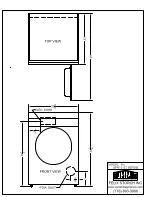
Pressure Washers
www.campbellhausfeld.com
Keep hose away
from sharp objects.
Bursting hoses may cause injury.
Examine hoses regularly and replace if
damaged. Do not attempt to mend a
damaged hose.
EXTENSION CORDS
If using an exten-
sion cord, use only
grounded, three wire extension cords
that are in good condition.
Use only extension cords that are intend-
ed for outdoor use. These extension
cords are identified by a marking
“Acceptable for use with outdoor appli-
ances; store indoors while not in use”.
!
DANGER
!
CAUTION
Use only extension cords having an elec-
trical rating not less than the rating of
the product.
Do not use damaged extension cords.
Examine extension cord before using
and replace if damaged. Do not abuse
extension cord and do not pull on the
cord to disconnect. Keep cord away from
heat and sharp edges. Always disconnect
the cord from the receptacle before dis-
connecting the product from the exten-
sion cord.
Note
: Do not use 16 or 18 AWG exten-
sion cords on this product.
Failure to follow
these instructions
can result in serious injury, including
death.
!
DANGER
4
Extension
Allowable length
Cord size
25’
50’
14 AWG
Yes
No
12 AWG
Yes
Yes
Pre-Operation
To reduce the risk of
electrocution, keep all connections dry
and off the ground. Do not touch plug
with wet hands.
ADJUSTING FAN PATTERN
The angle of spray coming out of the
lance may be adjusted by rotating the
nozzle. This will vary the spray pattern
from approximately a 0˚ narrow high
impact stream to a 60˚ wide fan spray
(See Figure 2).
A narrow stream has high impact force
on the cleaning surface and results in
maximum deep cleaning in a concen-
trated area. However, this narrow high
impact spray must be used cautiously, as
it may damage some surfaces.
A wide “Fan” pattern, will distribute
the impact of the water over a larger
area resulting in excellent cleaning
action with a reduced risk of surface
damage. Large surface areas can be
cleaned much quicker using a wide fan
pattern.
!
WARNING
ANGLE TO THE CLEANING SURFACE
When spraying water against a surface,
maximum impact is generated when
the water strikes the surface “Head
On”. However, this type of impact
tends to cause dirt particles to imbed in
the surface, thereby preventing the
desired cleaning action.
The optimum angle for spraying water
against a cleaning surface is 45 degrees.
Spraying water against a surface at this
angle provides for the most beneficial
impact force combined with efficient
removal of debris from the surface.
DISTANCE FROM CLEANING SURFACE
Another factor that determines the
impact force of the water is the distance
from the spray nozzle to the cleaning
surface. The impact force of the water is
increased as the nozzle is moved closer to
the surface.
HOW TO AVOID DAMAGING SUR-
FACES
Damage to cleaning surfaces occurs
because the impact force of the water
exceeds the durability of the surface.
The impact force can be varied by con-
trolling the three previously noted items.
Never use a narrow high impact stream,
or a Turbo/rotary nozzle on a surface
that is susceptible to damage. Avoid
spraying windows with a narrow high
impact stream or turbo nozzle as this
may cause breakage. The most sure way
to avoid damaging surfaces is to follow
these steps:
1. Before triggering the gun, adjust the
nozzle to a wide fan pattern.
Figure 2 - Adjusting nozzle for fan pat-
tern
Figure 3 - Narrow high impact stream
Figure 4 - Wide fan pattern
Safety and Warning Information (Continued)
REFER TO ASSEMBLY
INSTRUCTIONS FOR
ASSEMBLY, SET-UP AND
CONNECTION PROCEDURES
Figure 5 - Optimum Angle to Cleaning
Surface


























